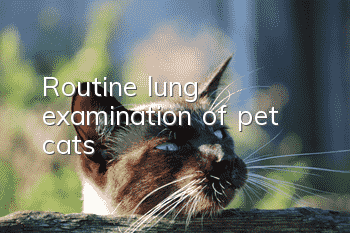Routine lung examination of pet cats

The lungs are respiratory organs. Like humans, the respiratory system of cats is also very delicate. For cats, respiratory symptoms may be caused by lesions in the lungs. Once sick, the respiratory tract can quickly enter a state of emergency. When diagnosing, it is very important to observe the cat's normal breathing patterns, and a lung examination is also necessary so that the best treatment can be adopted to ensure the health of the cat.
1. Routine inspection:
Pulmonary function test: for early detection of lung and airway lesions, identifying the cause of dyspnea, diagnosing the location of the lesion, assessing the severity of the disease and its prognosis, and evaluating the efficacy of drugs or other treatments.
Chest position: pneumonia, tuberculosis, lung cancer, lung abscess, pleurisy, cardiomegaly, mediastinal tumors, thymus tumors and other chest diseases.
Erythrocyte sedimentation rate examination: Accelerated erythrocyte sedimentation rate is seen in rheumatic fever, acute infectious diseases, active tuberculosis, pneumonia, sinusitis, cholecystitis, various anemias, leukemia, acute endocarditis, myocardial infarction and some malignant tumors, etc.
Internal medical examination: Check for abnormalities in the heart, lungs, liver, gallbladder, spleen, kidneys, intestines, and nervous system.
Computed tomography (CT) scan: It can be used in situations such as when ultrasound cannot provide a diagnosis. A CT scan can help determine whether a lung tumor can be surgically removed. If a cat is in respiratory distress due to fluid in the lungs, removing some of the fluid will provide emergency relief. The veterinarian will use a chest drain or tube for drainage, and once the cat is stable, other treatments can be used in conjunction with it.
2. Lung auscultation:
Bronchial breath sounds: The sound produced by the respiratory airflow forming turbulence in the glottis, trachea or main trachea, like the "ha" sound made by lifting the tongue and exhaling through the mouth. Bronchial breathing is high-pitched and loud. Compared with inhalation and exhalation, expiratory sounds are louder, higher-pitched and longer than inspiratory sounds. In normal cats, bronchial breath sounds can be heard in the larynx, suprasternal fossa, back near the 6th and 7th cervical vertebrae and the 1st and 2nd thoracic vertebrae.
Alveolar breath sounds: caused by the passage of respiratory air in and out of the bronchioles and alveoli. When inhaling, air flows through the bronchi into the alveoli, causing the alveoli to change from relaxed to tense, and when exhaled, the alveoli change from tense to relaxed. The alveolar breath sound is very similar to the "fu" sound made when the upper teeth bite the lower lip and inhales. It is a soft blowing sound with a lower pitch and a weaker sound. Compared with inhalation and expiration, inspiratory sounds are louder, higher pitched and longer than expiratory sounds. In normal cats, alveolar breath sounds can be heard in all other parts of the chest except the bronchial breath sounds and the bronchoalveolar breathing parts.
Low-key dry rales: also known as snores. Low pitch, its fundamental frequency is about100-200Hz, such as snoring in deep sleep, mostly occurring in the trachea or main bronchi.
Coarse rales: also known as large and small bubbles. It occurs in the trachea, main bronchus or cavity, and often occurs in the early stage of inspiration. Seen in bronchiectasis, severe pulmonary edema and tuberculosis or lung abscess cavities. Comatose or dying patients are unable to expel respiratory secretions and may hear rough and moist rales in the trachea. Sometimes they can be heard without a stethoscope, which is called phlegm.
Medium moist rales: also known as small and medium vesicles, occur in medium-sized bronchi and mostly appear in the middle period of inspiration. Seen in bronchitis or bronchopneumonia, etc.
Thin wet rales: also known as small vesicular rales. It occurs in the small bronchi and often appears during late inspiration. Commonly seen in bronchiolitis, bronchopneumonia, pulmonary congestion and pulmonary infarction.
Pleural friction rub: When the pleural surface becomes rough due to inflammation, pleural friction rub may occur with breathing. The nature of the sounds varies greatly, some sounds are soft and subtle, while others are rough. It can be heard on both inhales and exhales. Generally, it is more obvious when inhalation has not started and exhalation has begun. The sound disappears when you hold your breath, and increases when you take a deep breath. This can be used to distinguish it from pericardial friction rub. Make the sick cat cover its nose and mouth and strengthen its abdominal movements. At this time, although there is no airflow in and out of the airway, pleural friction rub sound can still be heard, which can be distinguished from crepitus. Pleural friction rub is most commonly heard on the anteroinferior chest wall because respiratory motion is greatest in this area.
- How tall can cat grass grow?
- Do cats miss their owners?
- Will Fold-eared cats die suddenly? Will Fold-eared cats die suddenly?
- Can Ragdoll cats eat chocolate candies?
- When raising a British Shorthair cat, is it better to choose a "male" or a "female" cat?
- Six key points of cat grooming care
- Will eating catnip cause hallucinations?
- Can kittens eat cat food?
- How is Mycoplasma feline infected?
- Cat vomits yellow water after eating freeze-dried food



